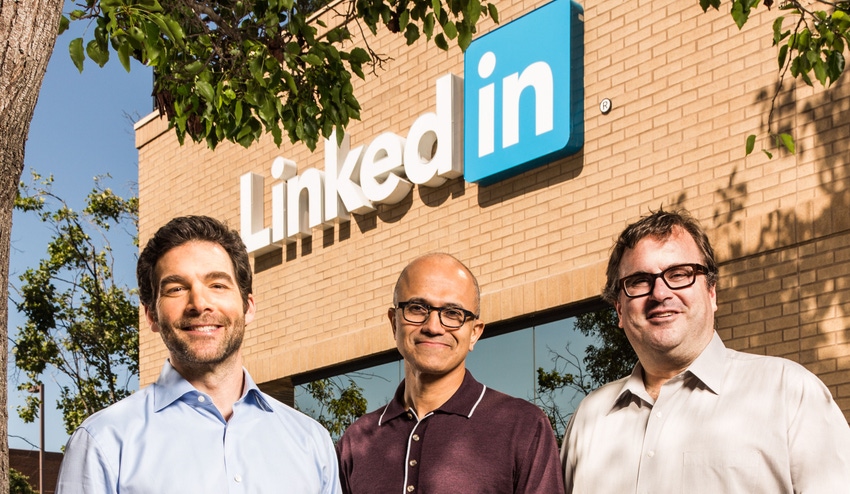The US Securities and Exchange Committee has released its filings outlining the road to Microsoft’s acquisition of LinkedIn, during which $5 billion was added to the value of the deal.
July 4, 2016

The US Securities and Exchange Committee has released its filings outlining the road to Microsoft’s acquisition of LinkedIn, during which $5 billion was added to the value of the deal.
Five parties were involved in the saga, which eventually led to the news breaking on June 13, with Microsoft agreeing to acquire LinkedIn in an all-cash deal worth $26.2 billion. Although it has not been confirmed by the companies themselves according to Re/code Party A, which kicked the frenzy, was Salesforce. Party B was Google, which was also interested in pursuing the acquisition.
Party C and Party D were contacted by LinkedIn CEO Jeff Weiner to register interest however both parties declined after a couple of days consideration. Party C remains unknown, though Party D is believed to be Facebook, who even if had shown interest in the deal, may have faced a tough time in passing the agreement by competition authorities.
In terms of the timeline, a business combination was first discussed by Weiner and Satya Nadella, Microsoft’s CEO during a meeting on February 16, with Party A being brought into the frame almost a month later on March 10. Salesforce CEO Marc Benioff has confirmed several times in recent weeks his team were in discussions with LinkedIn regarding the acquisition. In the following days, Party B was brought into the mix, also declaring interest. Once the interest of Party A and B were understood, Microsoft was brought back into the mix on March 15 with the report stating:
“Mr. Weiner called Mr. Nadella to inquire as to whether Microsoft was interested in discussing further a potential acquisition of LinkedIn, and explained that, although LinkedIn was not for sale, others had expressed interest in an acquisition. Mr. Nadella responded that he would discuss the matter further with Microsoft’s board of directors.”
Who do you think Party C was?
Private Equity (25%, 14 Votes)
Amazon (21%, 12 Votes)
Twitter (18%, 10 Votes)
Cisco (16%, 9 Votes)
Oracle (14%, 8 Votes)
HPE (5%, 3 Votes)
Total Voters: 56
Prior to the agreement LinkedIn was valued at roughly $130 per share, with the initial offer recorded at $160. Microsoft eventually paid $196 per share, though this was not the highest bid received. The company referred to as Party A in the document put an offer forward of $200 per share, though this would be half cash and half shares in the company. Weiner negotiating skills have seemingly added approximately 50% to the value of LinkedIn shares and bumping up the total value of the deal by $5 billion.
The exclusivity agreement was signed on May 14, though pressure had been put on LinkedIn by both Microsoft and Party A in the weeks prior. It would appear Party A had not been deterred by the agreement, as additional bids were made, once again driving up the perceived value of LinkedIn shares. Microsoft’s offer of $182 was no longer perceived high enough, and encouraged to match Party A’s offer of $200. The report states LinkedIn Executive Chairman Reid Hoffman was in favour of an all cash deal, allowing Microsoft extra negotiating room. Nadella was eventually informed on June 10 the offer had been authorized by the LinkedIn Transactions Committee.
Although Microsoft could be seen to overpaying on the price, it would be worth noting LinkedIn has been valued at higher. The company initially launched its IPO in 2011 and had a promising year in 2013 increasing the share price from $113.5 to over $200 across the 12 month period. Share prices rose to over $250 last November, following quarterly results in February, share prices dropped 44% after projected full-year revenues at $3.6 billion to $3.65 billion, versus $3.9 billion expected by analysts. Considering the fall in fortunes, it may be fair to assume shareholders would be pleased with the value of the deal approaching $200 per share.
While Microsoft has been a relatively quiet player in the social market prior to the acquisition, though this could be seen as a means to penetrate the burgeoning market segment. Although the place of social media in the workplace remains to be seen, Microsoft has essentially bought a substantial amount of data, including numerous high-net worth individuals and important decision makers throughout the world. LinkedIn currently has roughly 431 million members and is considered to be the largest professional social media worldwide.
Another explanation for the deal could be the value of Microsoft to IT decision makers. A report from JPMorgan stated Microsoft would be considered the most important vendor by CIOs to their organization due to the variety of services offered. AWS is generally considered to be the number one player in the public cloud market, though Microsoft offers a wider range of enterprise products including servers, data centres, security solutions, and cloud offerings, amongst many more. Now social can be added to the list. As Microsoft increases its offerings, it could penetrate further into a company’s fabric, making it a much more complicated decision to change vendor.
About the Author(s)
You May Also Like








.png?width=300&auto=webp&quality=80&disable=upscale)


_1.jpg?width=300&auto=webp&quality=80&disable=upscale)


.png?width=800&auto=webp&quality=80&disable=upscale)